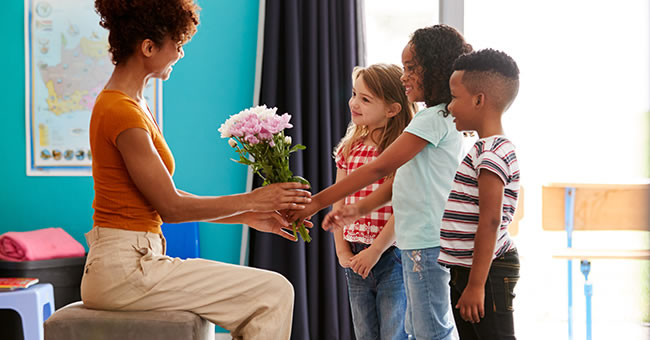
With the holiday season fast approaching it's the perfect time to incorporate thankfulness into your lesson plans! Teaching thankfulness is a wonderful way to support social-emotional development and cultivate meaningful connections in your classroom community. Easy-to-include, and rich with teaching possibilities, thankfulness is an idea that can be explored in endless ways for interdisciplinary learning.
Taking time out of a busy holiday schedule to encourage students to think about what they are thankful for, how they can share gratitude with others, and what they can do to pay their thankfulness forward, is the perfect way to practice mindfulness and bring a moment of calm to your learners. Children will love sharing what they're thankful for with the group and hearing what their classmates are thankful for, too.
Why Is Teaching Thankfulness Important?
Thankfulness, or gratitude, is the act of being not only aware, but thankful for the good things that happen in life. Similar to learned emotions like empathy and compassion, the concept of thankfulness is important to teach to children. If children do not learn about gratitude at an early age, they can easily begin to take things for granted or believe that they are entitled to certain items or treatment. Finding ways to encourage children to practice gratitude at school and at home is essential to their emotional development.
It is important to note that thankfulness can be taught and practiced year round, not just during holidays like Thanksgiving. Incorporating thankfulness into holiday activities helps provide children with a more concrete example of what thankfulness is, but it can be implemented during non-holiday times as well.
How Can I Use This In My Lesson Plan?
To many, Thanksgiving is the perfect opportunity to share lessons focusing on thankfulness through the story of the first Thanksgiving feast the Pilgrims and Native Americans shared together. However, now we know that the tales of the first Thanksgiving largely tell only one side of the story—that of the Pilgrims—and not the true history of the Native Americans that were displaced by the arrival of the Pilgrims. Because of this, even well-meaning lessons focusing on the Pilgrim's journey or the harvest celebration of the first Thanksgiving, can unintentionally teach young children damaging misinformation and stereotypes.
There are several thoughtful alternatives to, what we may consider, traditional Thanksgiving lesson plans and activities. For example, some teachers choose to use Thanksgiving to appreciate Native Americans as they are today and share an introduction to their rich heritage, cultural traditions and practices, and contributions to our communities. Carrying out a variety of activities on this subject leading up to, during, and after the Thanksgiving holiday is a good way to reinforce multicultural learning in your classroom and share well informed lessons on the lives of Native Americans with your students.
Teaching thankfulness is another inclusive alternative to traditional Thanksgiving activities. Instead of relying on the story of the first Thanksgiving to teach sharing and gratitude, presenting the values of this story through mindfulness, acts of service, and direct expressions of thankfulness is a wonderful way to establish meaningful connections within your classroom and your local community, encourage family engagement, and support crucial social-emotional development.
Teach thankfulness in your classroom this Thanksgiving, and year round, with these easy-to-incorporate lesson plan ideas!
- Give Back
One of the best ways to teach children about gratitude is by incorporating service-learning projects into your classroom. Make a list of local organizations in need of help and then ask students to decide as a group which organization they'd like to help as a team. Some organizations have age restrictions, so make sure ahead of time that the options are appropriate for young volunteers. Extend this exercise in gratitude by having children come up with project ideas like a toy drive or canned food drive that can have a positive impact on your local community. Throughout this process, ask children to reflect on their feelings and what they're learning. Encourage open-ended class discussion with questions like What is a community? How can we help our community? How does it make you feel when someone shares with you? and Why is it important we give back to our community?
- Practice Mindfulness
Teaching thankfulness is the perfect opportunity to practice mindfulness with students. Encourage students to take a quiet moment to reflect on what they are thankful for in their life, it could be anything—their family, their friends, even their favorite toy. Then ask students, if comfortable, to write or draw their thoughts in a journal, or share their answers with their classmates. Next, ask them why they are thankful for what they shared and encourage the class to have a discussion about what thankfulness is and why it is important. Giving students the space they need to freely explore thankfulness and share their feelings allows them a chance for introspection while building crucial social-emotional skills. Extend this mindfulness exercise by encouraging students to reflect on times they've shown gratitude or paid their gratitude forward.
- Show Your Appreciation
What better way to teach thankfulness than to show it! If your school has a support staff such as janitorial workers, office assistants, or cooks, make a card as a class showing your gratitude for all of their hard work! Extend this activity by encouraging students to write thank-you notes to community helpers or even their families to express how thankful they are for them and all they do.
